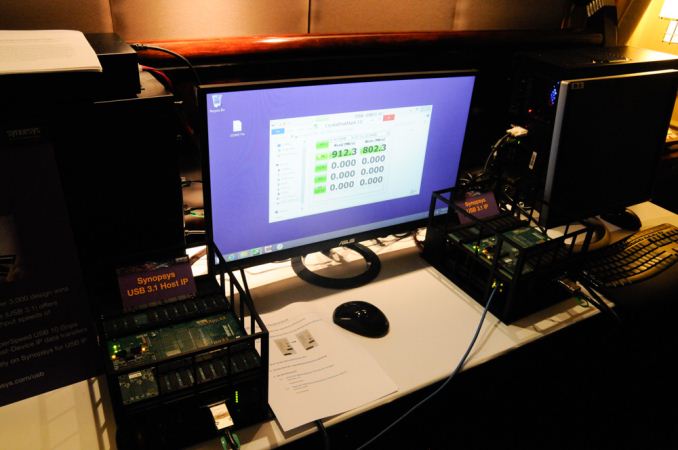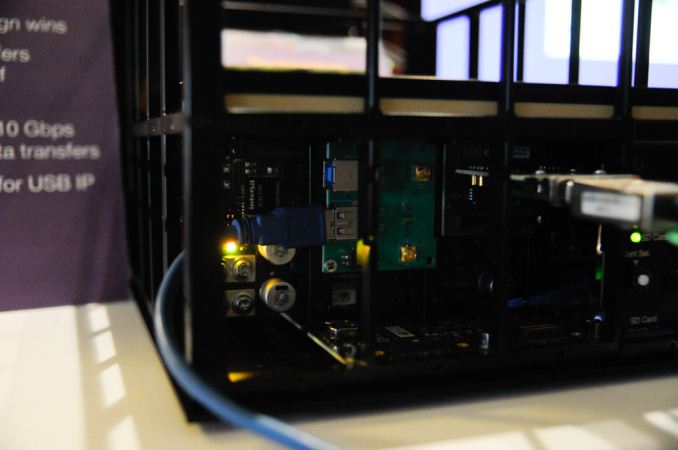USB-IF Updates Us on Type C Connector, Demonstrates USB SuperSpeed 3.1 Transfers
by Brian Klug on January 7, 2014 2:36 PM EST- Posted in
- Trade Shows
- CES
- USB-IF
- CES 2014
- USB 3.1

December of last year, the USB-IF announced that the definition of a new type of compact connector, dubbed type C, was underway. After pushback from the USB 3.0 micro-B connector, which added a lobe for the USB 3.0 data lines in addition to the signaling and port for USB 2.0 micro-B, many saw the definition of a type C connector as a way to learn from previous lessons and design a connector for better, sleeker industrial designs and with a new emphasis on mobile devices like tablets and smartphones.
The type C connector is still in development, and there aren't any current renderings or drawings, but what has been laid out are the design goals for the new connector design. The connector will be reversible, and able to negotiation which end is host or client (direction-agnostic) with type c connectorization at both ends, although cables will still come in type-A to type-C combinations for use with power adapters and current generation hosts. In addition it will be around the same size as the current USB 2.0 Micro-B connector and catered toward enabling the kinds of thin and sleek industrial designs smartphone, tablet, and even notebook OEMs desire. Type C will work with USB 3.1 and the power delivery specification, in addition to including some extra pins for growth and building out the standard in the future, the goal is to make this the connector for the next 10 years. In addition, the standard will define an intermediary adapter for going from current 2.0 or 3.0 micro-B connectors to the new type C connector. I'm told to expect the Type C connector to have drawings and be better understood probably before the next IDF.
In addition USB-IF showed two demos of USB 3.1, the new standard which enables up to 10 Gbps transfer speeds by doubling the clock rate and also moving to a more efficient 128b/132b coding scheme with just 3 percent overhead, compared to the 20% overhead in 10b/8b from USB 3.0. Both demos were implemented on FPGAs, and showed transfer rates right around 1 GB/s (8 Gbps), the second using Synopsis' FPGA implementation over current generation USB 3.0 cables.
















31 Comments
View All Comments
ishmoo21 - Tuesday, January 7, 2014 - link
So if they can use type c to type c from the power adapter to device, what is the point of making the power adapters type a?extide - Tuesday, January 7, 2014 - link
There isnt one. The Type A to type C cables are for backwards compatibility. The idea is to have the 'new' type C connector on everything eventually.SeeManRun - Tuesday, January 7, 2014 - link
Round connectors are always the easiest to plug in.. why not make it round for once.sgupt - Tuesday, January 7, 2014 - link
Round takes up more space than flat, simple as that.spikebike - Wednesday, January 8, 2014 - link
So? There's a round earphone jack on most phones/tablets already. My 10 year old dumb phone had a round charger, why not today's phones? Name a single device today to thin for an audio jack.spikebike - Wednesday, January 8, 2014 - link
Sigh, too thin.psychobriggsy - Wednesday, January 8, 2014 - link
Audio jacks are okay for around 4 or 5 different signals, but it looks like they'll require more pins for this connector. A reversible flat connector is easy to plug in.wolrah - Wednesday, January 8, 2014 - link
There are two reasons why not to use a round connector for USB or similar roles. First is power, a round connector makes it a lot harder to do hotplug safely, where the ground connects first and power can not inadvertently be shorted to other pins by partial or offset insertion. Live power also shouldn't be connected to exposed surfaces.The second reason is high-speed signaling is very picky about electrical connections and positioning. Note how ethernet doesn't just connect the four pairs in 12345678 order, but mixes them up. This is to keep the signal lines appropriately separated. A connector that works over its width is a lot easier to do this with than one that has to be inserted inline.
A barrel plug like is usually used for power doesn't cut it for multiple signals and a stereo/headphone style jack has exposed conductors. Pretty much anything else isn't able to be inserted rotated, which would be the whole benefit of a round connector. Otherwise you end up with DIN-style connectors (think PS/2, ADB, and S-Video) which are just as bad as USB in terms of plugging in blind.
BillyONeal - Tuesday, January 7, 2014 - link
Round is even worse than the current design -- can't tell which way is up, and don't have only 2 orientations to try.I think the 6 conductor FireWire connector (with the rounded end but square on the other end) is probably the best thing ever here.
CharonPDX - Tuesday, January 7, 2014 - link
Only problem - over time the connectors can become loose, making it possible to plug it in backwards.Which then puts high amperage power over the data lines.
Which is a bad thing.
(I'm sure you can guess how I know this.)